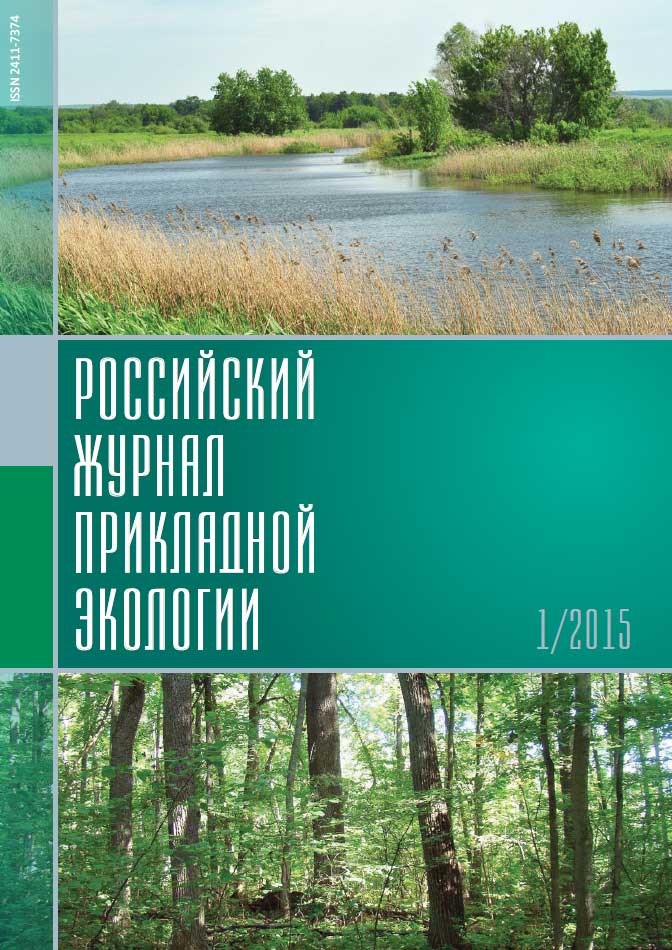Soil mesofauna functional traits in Kazan city suburbs
Keywords:
soil invertebrates, abundance, suburbs, monitoringAbstract
The abundance and diversity of soil invertebrates communities in urban forests of Kazan are studied. Multidimensional scaling revealed significant differences in communities structures at different biotopes. Earthworms, insects and millipedes prevailed in all plots.
References
Велегжанинов И.О., Канева А.В., Белых Е.С., Майстренко Т.А., Шадрин Д.М., Пылина Я.И. Генотоксические эффекты у дождевых червей с техногенно-загрязненной территории // Проблемы почвенной зоологии / Матер. XVII Всеросс. совещания по почвенной зоологии. М., 2014. С. 53–54.
Водунон Н.Р., Гордиенко Т.А., Сабанцев Д.Н. Почвообитающие беспозвоночные в градиенте антропогенного воздействия // Любищевские чтения – 2014. Современные проблемы эволюции и экологии / Сб. матер. междунар. конф. Ульяновск, 2014. С. 290–294.
Жеребцов А.К. Оценка устойчивости биологических систем с использованием жужелиц (Coleoptera, Carabidae) в качестве модельного объекта // Актуальные экологические проблемы Республики Татарстан / Тез. докл. VI республ. научной конф. Казань, 2004. С. 80–81.
Кадастр сообществ почвообитающих беспозвоночных (мезофауна) естественных экосистем Республики Татарстан. Казань: Казанский университет, 2014. 308 с.
Стриганова Б.Р., Емец В.М. Закономерности пространственно-временной динамики разнообразия почвенной мезофауны (на примере жуков-щелкунов Elateridae, Coleoptera) // Известия РАН. Сер. биологическая. 1998. №6. С. 717–724.
Colwell R.K., Lees D.C. The mid-domain effect: geometric constraints on the geography of species richness // Trends in Ecology and Evolution. 2000. V. 15. P. 70 – 76.
Duelli P., Obrist M.K. Biodiversity indicators: the choice of values and measures // Agriculture. Ecosystems and Environment. 2003. V. 98. P. 87–98.
Fountain‐Jones N. M., Baker S. C., Jordan G. J. Moving beyond the guild concept: developing a practical functional trait framework for terrestrial beetles // Ecological Entomology. 2015. V. 40. Р.1–13.
Gongalsky K.B., Filimonova Zh.V., Zaitsev A.S. Relationship between soil invertebrate abundance and soil heavy metal contents in the environs of the Kosogorsky metallurgical plant, Tula Oblast // Russian Journal of Ecology. 2010. V. 41. P. 67–70.
Jiang Y., Yin X., Wang F. Impact of soil mesofauna on the decomposition of two main species litters in a Pinus koraiensis mixed broad-leaved forest of the Changbai Mountains // Acta Ecologica Sinica. 2014. V. 34-2. P. 110–115.
McIntyre N.E. Ecology of urban arthropods: a review and a call to action // Annals of the Entomological Society of America. 2000. V. 93 P. 825–835.
Menezes S., Baird D., Soares A. Beyond taxonomy: a review of macroinvertebrate trait-based community descriptors as tools for freshwater biomonitoring // Journal of Applied Ecology. 2010 V. 47. P. 711–719.
Santorufo L., Van Gestel C.A.M., Rocco A., Maisto G. Soil invertebrates as bioindicators of urban soil quality // Environmental Pollution. 2012. V.161. P. 57–63.
Sattler T., Duelli P., Obrist M.K., Arlettaz R., Moretti M. Response of arthropod species richness and functional groups to urban habitat structure and management // Landscape Ecology. 2010. V. 25. P. 941–954.
Scharenbroch B.C., Johnston D.P. A microcosm study of the common night crawler earthworm (Lumbricus terrestris) and physical, chemical and biological properties of a designed urban soil // Urban. Ecosystems. 2010. V.14. P. 119-134.
Downloads
Published
How to Cite
Issue
Section
License

This work is licensed under a Creative Commons Attribution-NonCommercial 4.0 International License.





